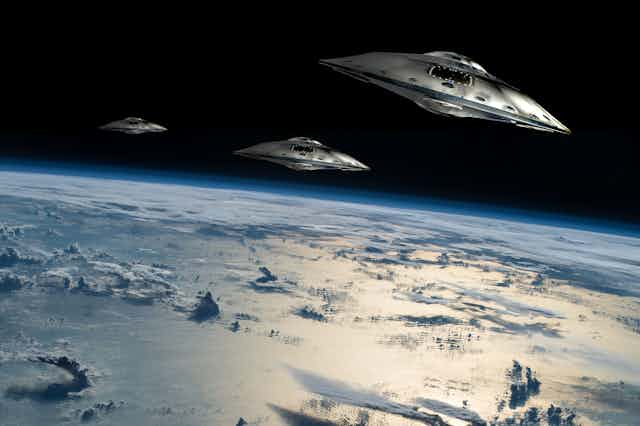The US leadership has plans to introduce a “US Space Force” by 2020. Already announced by president Donald Trump in June, US vice president Mike Pence outlined further details of the plan at a press conference on August 9. The Space Force, he said, would consist of an elite corps of soldiers trained to fight in space, and a space command that would design military strategies for warfare beyond the atmosphere.
Much acrimony and ridicule has ensued, with debates over what such a force could or could not do; the only certainty being that it will cost billions of dollars. Seasoned watchers of both US politics and US science fiction will have had the uncanny feeling, though, of having seen this all before.
The rhetoric of both Pence and Trump, referring respectively to “the boundless expanse of space” and the necessity for “American dominance”, is inherently science-fictional, but of a particularly American kind. It is not the cooperatist vision of Soviet science fiction, nor the ramshackled approach of British sci-fi (take Doctor Who), and certainly not the Afrofuturist marriage of esoteric technology and indigenous folklore, seen most recently in Ava DuVernay’s A Wrinkle in Time.
An American fiction
Instead, it is the projection of the values of Manifest Destiny (that the settler population has an inalienable right to the uncharted lands) into outer space. Not for nothing did Trump’s 2020 reelection campaign manager, Brad Parscale, write that Space Force would be “a groundbreaking endeavor for America and the final frontier”.
As film and media studies expert, Constance Penley, observed in her 1997 book, NASA/Trek, the Cold War politics of the Space Race dovetailed beautifully with the frontier vision of Gene Roddenberry’s Star Trek. This is particularly true of the pioneer spirit of (to paraphrase the original series’ opening words) exploring “strange new worlds”, seeking “out new life and new civilisations”, and “boldly” going “where no man has gone before”.
Roddenberry himself was in a lineage of writers from Edgar Rice Burroughs to Ray Bradbury who, with varying degrees of scepticism, projected frontier values into outer space (most typically, onto the surface of Mars). And as historian Frederic Krome has shown, future war stories published in the US pulps between 1914 and 1945 fed into the cultural and military thinking of how to plan for future conflicts.
Perhaps most bizarrely, the mission to capture Saddam Hussein during the Iraq War was named after John Milius’s post-apocalyptic teen movie, Red Dawn (1984).
Indeed, the Strategic Defence Initiative (SDI), envisaged by president Ronald Reagan in 1983, not only became known as “Star Wars”, but its rhetoric was also derived from science fiction writers such as Ben Bova and Jerry Pournelle. SDI’s vision of a circling belt of laser-armed satellites, protecting the US from Soviet attack, chimed perfectly with Pournelle’s dream, and with that of other science fiction writers such as Robert Heinlein and Larry Niven – an American renaissance through the militarisation and colonisation of space.
Read more: Donald Trump’s Space Force isn't as new or as dangerous as it seems
Space force rebooted
The current rhetoric of Pence and Trump, in announcing their Space Force, almost exactly echoes the rhetoric of SDI and its then supporters. Both groups posit a pattern of US military decline, under the alleged negligence of previous administrations, in which space, the “natural” home of the US following the moon landings, has been left exposed to foreign aggressors. According to them, it is their enemies, not the US, who have militarised space. And now, they argue, only a show of strength can make space safe again for US democracy.
In this way, the ratcheting-up of an arms race in space is glossed over by a utopian vision, in which the US is regalvanised by dreams of expansion into space – see, for example, the proposed mission to Mars.
There has been genuine concern since 2007, when China shot down one of its own satellites. But to imply that space has only now begun to be militarised glosses over the steady militarisation of space since the 1960s, while even supporters of the proposal suggest a cyber-hacking force is more necessary.
Instead, the proposal for an elite corps of specialised soldiers and strategists sounds more like Heinlein’s controversial novel of a fully militarised society, Starship Troopers (1959), in which humans are embroiled in a seemingly endless war against the utterly alien “Bugs”. There are echoes too of E E Smith’s interstellar police force, Galactic Patrol (1937), and even the BBC’s more low-key Star Cops (1987), glumly policing off-world mining colonies in the outer solar system. Of course, the proposal may never take flight – it would still require an Act of Congress – so these more hyperbolic fears and desires may need to be momentarily put aside.
Instead, what we can deduce from the proposal is that we are firmly in the logic of the reboot, that much loved tactic of longrunning movie franchises. But, as science fiction scholar Gerry Canavan has argued, the reboot “can show us a story, but can’t tell us a plot”. Rather than an original and inspiring vision of space exploration, what we have instead here is a meaningless reiteration of past rhetoric that may, quite literally, go nowhere.

